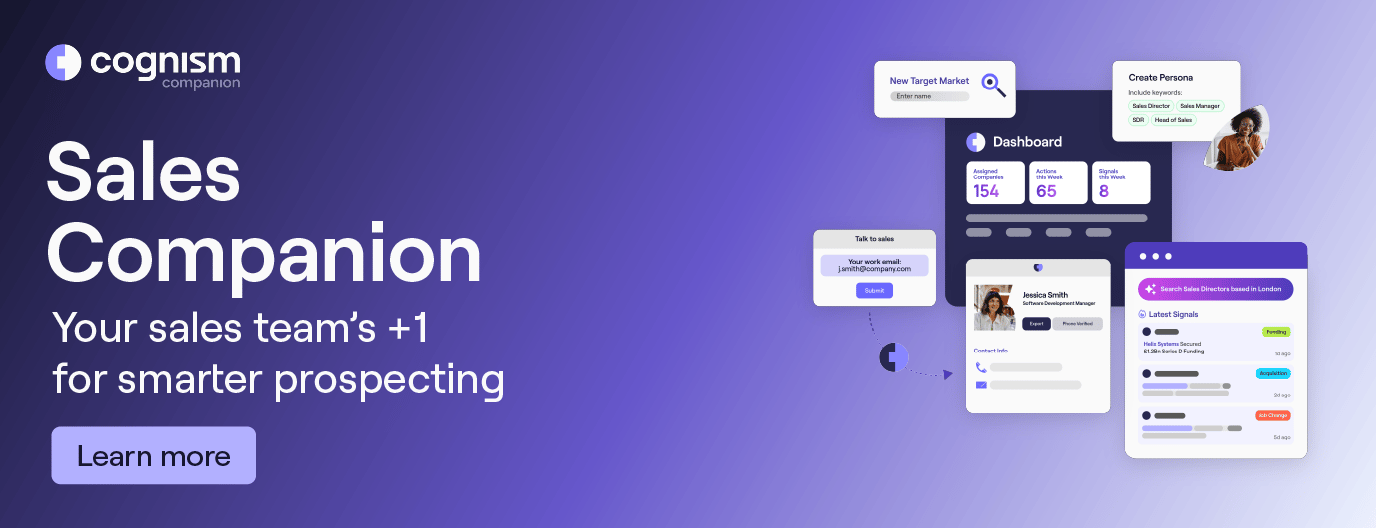What Is Revenue Generation? [+Strategies]
Revenue generation is the process of planning, marketing, and selling products, with the ultimate aim of generating income and increasing profitability. Generating revenue is the most important activity that B2B companies engage in.
Here, you’ll learn about revenue growth and the strategies to make it successful.
Scroll 👇 or use the menu to skip to a section.
What is a revenue strategy?
Revenue generation may involve some or all of the following tasks:
- Establishing the business goals for the financial year, e.g., monthly or annual revenue targets.
- Aligning the B2B sales and marketing strategy to match the revenue targets.
- Creating an organisational structure that ensures the successful implementation of the revenue generation strategy.
- Reviewing sales and marketing procedures and making sure that best practice is applied in all areas of the business.
- Using metrics to measure the progress of revenue generation and adjusting the strategy as necessary.
- Providing Revops tools, training and education for staff so that all colleagues work to maximise revenue generation.
How to increase revenue
B2B organisations can generate more revenue by enhancing and automating their strategy with B2B data.
What can data do for your marketing, sales and customer success teams?
It helps marketing teams target the right audiences and empowers SalesOps to have more conversations. The teams that generate the most revenue enrich their data using sales intelligence tools like Cognism and ZoomInfo.
Using low-quality data to generate leads, build B2B contact databases, or create marketing messages will result in a broken sales funnel.
As a result, your salespeople will struggle to identify new sales leads, leading to a decline in booked meetings and closed-won deals.
Having high-quality B2B data means you’ll be able to track and measure the performance of your revenue team. You’ll gain insights, enabling you to make amendments to improve your product, sales process, and marketing campaigns.
And there’s data to back this up!
According to a Forrester study, B2B companies implementing comprehensive data analytics are seeing up to a 15% increase in revenue growth over competitors who lag in this area.
YuLife streamlined revenue generation thanks to Cognism’s Diamond Data®. Read the complete YuLife case study or speak to our team to find out more 👇
6 effective revenue generation strategies
If you want to keep your business afloat and increase its financial health, you’ve got to increase your revenue.
Here are some tactics you can use in your revenue generation strategy:
1. Establish your goals
In B2B SaaS sales, your starting point for generating revenue must be creating a strategy that aligns with your revenue goals.
As you continue on your revenue generation journey, you must continue to define your revenue goals at each stage of your business’s growth.
2. Build a high-performing outbound sales team
A great model for B2B companies is the one we use here at Cognism.
Based on these clearly outlined roles, split your team into two ‘pods’:
-
Sales Development Representatives (SDRs): responsible for creating opportunities and booking meetings.
-
Account Executives (AEs): responsible for closing deals and generating revenue for the business.
Adopting this business model means your teams have to work together to accelerate your revenue generation.
3. Deploy revenue-focused marketing strategies
The best way to accelerate your revenue generation is to let marketing own revenue targets.
Your marketing team can use one or all of the following three strategies to do so:
Content marketing
Your marketing team should use and repurpose your existing content - such as blog articles, videos, social media posts, etc., to attract, engage, and retain your audience.
Don’t believe us?
A recent HubSpot report highlights that 70% of marketers actively invest in content marketing, citing a direct correlation with enhanced revenue generation.
Performance marketing
AKA paid marketing; this is where your marketing team pays for online advertisements but only when a specific action is completed, e.g., a prospect clicking on an ad.
Campaign marketing
Your marketing team should run various campaigns on different online marketing platforms. The goal is to appeal to your target audience, get them excited about your product, and convert them into paying customers.
4. Be flexible with your pricing plan
In B2B SaaS sales, pricing is not one-size-fits-all.
Continuously evaluate and test your pricing strategy based on customer feedback. You should attribute it to personas and base it on the correct value measures.
5. Constantly evolve your product
You need to develop your product consistently over time. The characteristics of your early-stage product will likely be vastly different from that of your mature product.
In order to evolve your product, you’ve got to listen to your customers’ needs. Add new features and remove those that are no longer benefiting your clients.
Your revenue generation will stagnate if your customers aren’t happy with your product!
6. Focus on upselling and cross-selling
Selling to your existing customer base is much easier than selling to new ones. This is where your customer success team comes into its own. They can cater to your customers’ needs and upsell or cross-sell based on what the client is lacking or looking for.
Cross-selling and upselling are critical to your revenue generation strategy, especially as your business scales.
Who is responsible for revenue generation?
In B2B sales, three departments are responsible for revenue generation: sales, marketing, and customer success. Sometimes, these teams are combined and referred to as the revenue team.
Sales
Composed of sales managers, sales reps, AEs, and lead generation specialists, your sales team is responsible for meeting and beating the goals your organisation sets.
The team generates revenue through lead generation strategies, outreach to prospects, negotiation of deals, and closing business. An account management team may also assist with customer acquisition and retention.
Marketing
Your B2B marketing team targets the needs, interests and pain points of your prospects.
The team generates revenue through their outbound marketing efforts, usually in the form of campaigns, content marketing and online ads.
These activities bring in targeted leads for your sales team to follow up on.
Customer success
Your customer success team forms part of your company’s wider engagement strategy. The team works with customers, ensuring they flourish by proactively meeting their needs and helping them achieve their sales goals.
Your customer success team generates revenue by boosting your key metrics (renewal rates, customer loyalty, and retention) and reducing churn.
FAQs
What is a revenue generating activity?
A revenue generating activity refers to any business action/process that directly contributes to generating income or sales.
These activities (also called revenue sources) are essential for sustaining and growing a business because they directly impact a company’s financial health.
Here are some examples of revenue generating activities in B2B:
- Sales: The process of selling products or services to customers, whether through direct sales, online sales, or other channels.
- Marketing and advertising: Activities designed to promote products or services to attract customers and drive sales.
- Customer relationship management: Building and maintaining relationships with customers to encourage repeat business and referrals.
- Product development: Creating new, innovative products (or improving existing ones) to meet customer needs and increase sales opportunities.
- Pricing strategies: Setting prices that maximise revenue while retaining market competitiveness.
- Partnerships and alliances: Collaborating with other businesses or organisations to expand reach and access new target markets.
- After-sales service: Providing support, maintenance, or additional services to customers after a purchase; the goal is to enhance satisfaction and encourage loyalty.
- Subscription and membership: Offering subscription-based services or memberships that provide a steady stream of recurring revenue.
What is the difference between generating revenue and profit?
Generating revenue and making a profit are two key aspects of financial performance for any business.
Here are the differences between them:
1. Revenue
- Revenue refers to the total income generated from selling goods or services during a specific period.
- It’s often referred to as the “top line” because it appears at the top of a business’s income statement.
- Revenue can come from various sources, such as product sales, service fees, subscriptions, advertising, etc.
- Revenue doesn’t take into account the expenses incurred in generating that income.
2. Profit
- Profit, on the other hand, is the financial gain realised after deducting all expenses from total revenue.
- It’s often referred to as the “bottom line” because it appears at the bottom of the income statement.
- Profit is the surplus remaining after deducting the costs of goods sold, operating expenses, taxes, interest, and any other expenses from total revenue.
- Profit indicates the financial health and efficiency of a business in generating returns from its operations.
Revenue vs profit: summary
- Revenue represents the total income generated by a business. It’s essential for a business’s growth and sustainability.
- Profit represents the financial gain after deducting all expenses from that revenue. It’s crucial for assessing profitability and long-term viability.
Why is it important to generate revenue?
Generating revenue is crucial for several reasons:
1. Financial sustainability
Revenue is the lifeblood of any business. It’s what keeps the lights on, pays employees’ salaries, covers operational costs, and enables investments in growth and innovation.
To ensure steady cash flow, businesses should calculate their DSO using the DSO formula, which helps track how quickly they collect revenue from sales. After all, without sufficient revenue, a business can’t survive in the long run!
2. Meeting financial obligations
Revenue is essential for a company to meet its financial obligations, such as paying suppliers, servicing debts, fulfilling tax liabilities, and other operational expenses.
Lack of revenue can lead to cash flow problems and, ultimately, financial distress.
3. Investment and growth
Revenue provides the capital needed to invest in expanding the business, developing new products/services, entering new markets, or acquiring assets.
It fuels growth opportunities and allows businesses to capitalise on emerging market trends and opportunities.
4. Attracting investors and stakeholders
Investors, lenders, and other stakeholders assess a company’s revenue performance as a key indicator of its financial health and potential for returns.
Consistent revenue growth and profitability make a business more attractive to investors, who in turn help raise capital for expansion or strategic initiatives.
5. Competitive advantage
Generating revenue is essential for maintaining a competitive position in the market.
Businesses that can effectively attract and retain customers through revenue-generating activities can outperform competitors, gain market share, and establish a stronger foothold in their industry.
6. Innovation and adaptation
Revenue generation often involves understanding customer needs, market trends, and evolving industry dynamics.
The process encourages businesses to innovate, adapt, and stay relevant to customer demands. This drives ongoing improvements in products, services, and processes.
Find out how to build the best RevOps tech stack.
7. Job creation and economic growth
Revenue generation enables businesses to create employment opportunities, contributing to economic growth and prosperity.
When businesses thrive and expand, they create more jobs, stimulate consumer spending, and support the overall economy.
What are the revenue generating teams?
Revenue generating teams are departments or groups whose primary responsibility is to directly contribute to the generation of income or sales.
These teams typically play a vital role in driving revenue growth and sustaining the financial health of the organisation.
Here are some common revenue generating teams found in many businesses:
1. Sales team
Sometimes called the business development team, they’re responsible for:
- Identifying qualified leads.
- Building relationships with profitable customers.
- Conducting product demos either online or in person.
- Closing deals to generate sales revenue.
They operate through sales strategies such as cold calling, email, video prospecting and social selling.
2. Marketing team
Tasked with promoting products or services to attract potential customers and drive sales.
They utilise RevOps marketing strategies and channels such as social media, content marketing, email marketing, and events.
As well as creating a delightful customer experience and increasing brand awareness, marketing’s role is to generate high-quality leads.
3. Customer success/account management team
Focused on maintaining relationships with existing customers, ensuring their satisfaction, and driving upsell and cross-sell opportunities.
They aim to maximise customer lifetime value and retention, which ultimately contributes to revenue growth.
4. Product development team
While not directly involved in sales, the product development team plays a crucial role in revenue generation. They listen to market trends and deploy the insights learned to create innovative products or improve existing ones.
Their efforts aim to meet customer needs, enhance product value, and stimulate demand.
Revenue operations (RevOps) team
The revenue operations team is responsible for aligning sales, marketing, and customer success functions. Their aim is to optimise revenue generation processes.
They focus on data analytics, process improvement, and technology integration that drives efficiency and effectiveness across the company.
You might be interested in learning more about the Revops team structure.
Cognism = the ultimate revenue generating tool
With over 3k revenue teams meeting and beating targets using Cognism Sales Companion, it’s the perfect choice to solve your revenue challenges.
Using our tools means you’ll be able to prospect predictably and in full compliance with global data laws. You’ll be able to identify and engage with your dream customers faster than ever before.
Click 👇 to speak with one of our experts.
/CTAs%20(SEO)/CTA%20banner-Ideal%20customers..webp?width=672&height=258&name=CTA%20banner-Ideal%20customers..webp)

/Cold%20calling%20strategy/cold-calling-strategy-card.webp)

